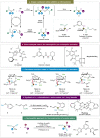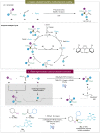Challenges and recent advancements in the synthesis of α,α-disubstituted α-amino acids
- PMID: 38368416
- PMCID: PMC10874380
- DOI: 10.1038/s41467-024-45790-2
Challenges and recent advancements in the synthesis of α,α-disubstituted α-amino acids
Abstract
α,α-Disubstituted α-amino acids (α-AAs) have improved properties compared to other types of amino acids. They serve as modifiers of peptide conformation and as precursors of bioactive compounds. Therefore, it has been a long-standing goal to construct this highly valuable scaffold efficiently in organic synthesis and drug discovery. However, access to α,α-disubstituted α-AAs is highly challenging and largely unexplored due to their steric constraints. To overcome these, remarkable advances have been made in the last decades. Emerging strategies such as synergistic enantioselective catalysis, visible-light-mediated photocatalysis, metal-free methodologies and CO2 fixation offer new avenues to access the challenging synthesis of α,α-disubstituted α-AAs and continuously bring additional contributions to this field. This review article aims to provide an overview of the recent advancements since 2015 and discuss existing challenges for the synthesis of α,α-disubstituted α-AAs and their derivatives.
© 2024. The Author(s).
Conflict of interest statement
The authors declare no competing interests.
Figures










Similar articles
-
Recent approaches towards the asymmetric synthesis of alpha,alpha-disubstituted alpha-amino acids.Org Biomol Chem. 2007 Feb 7;5(3):406-30. doi: 10.1039/b611091f. Epub 2006 Nov 30. Org Biomol Chem. 2007. PMID: 17252120 Review.
-
Asymmetric α-arylation of amino acids.Nature. 2018 Oct;562(7725):105-109. doi: 10.1038/s41586-018-0553-9. Epub 2018 Oct 3. Nature. 2018. PMID: 30283103
-
Synergistic Cu/Pd Catalysis for Enantioselective Allylic Alkylation of Aldimine Esters: Access to α,α-Disubstituted α-Amino Acids.Angew Chem Int Ed Engl. 2017 Sep 25;56(40):12312-12316. doi: 10.1002/anie.201707019. Epub 2017 Aug 23. Angew Chem Int Ed Engl. 2017. PMID: 28741842
-
Highly Sterically Hindered Peptide Bond Formation between α,α-Disubstituted α-Amino Acids and N-Alkyl Cysteines Using α,α-Disubstituted α-Amidonitrile.J Am Chem Soc. 2022 Jun 15;144(23):10145-10150. doi: 10.1021/jacs.2c02993. Epub 2022 Jun 6. J Am Chem Soc. 2022. PMID: 35658430
-
Radical-Based Synthesis and Modification of Amino Acids.Angew Chem Int Ed Engl. 2021 Jan 18;60(3):1098-1115. doi: 10.1002/anie.202010157. Epub 2020 Nov 4. Angew Chem Int Ed Engl. 2021. PMID: 32841470 Free PMC article. Review.
Cited by
-
Interplay between Cα Methylation and Cα Stereochemistry in the Folding Energetics of a Helix-Rich Miniprotein.Chembiochem. 2025 Mar 15;26(6):e202401022. doi: 10.1002/cbic.202401022. Epub 2025 Jan 24. Chembiochem. 2025. PMID: 39791987 Free PMC article.
-
Asymmetric Intramolecular α-Arylation of Polar Amino Acids Bearing β-Leaving Groups.Angew Chem Int Ed Engl. 2025 Jul;64(29):e202507713. doi: 10.1002/anie.202507713. Epub 2025 May 24. Angew Chem Int Ed Engl. 2025. PMID: 40333341 Free PMC article.
-
Photoinduced copper-catalysed deracemization of alkyl halides.Nature. 2025 Apr;640(8057):107-113. doi: 10.1038/s41586-025-08784-8. Epub 2025 Apr 2. Nature. 2025. PMID: 40175756
-
Advances in Peptidomimetics for Next-Generation Therapeutics: Strategies, Modifications, and Applications.Chem Rev. 2025 Aug 13;125(15):7099-7166. doi: 10.1021/acs.chemrev.4c00989. Epub 2025 Jul 23. Chem Rev. 2025. PMID: 40698392 Free PMC article. Review.
-
Room temperature, metal-free, CDI-promoted, ex-situ protocol for S-methyl thioester synthesis.Sci Rep. 2025 May 27;15(1):18561. doi: 10.1038/s41598-025-97728-3. Sci Rep. 2025. PMID: 40425747 Free PMC article.
References
-
- Koda Y, et al. Similarities of the biological activities of coronatine and coronafacic acid to those of jasmonic acid. Phytochemistry. 1996;41:93–96. doi: 10.1016/0031-9422(95)00517-X. - DOI
Publication types
MeSH terms
Substances
LinkOut - more resources
Full Text Sources

